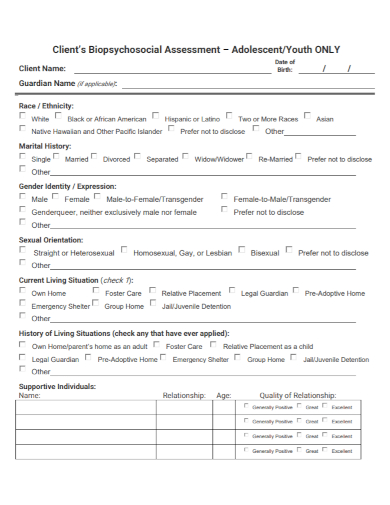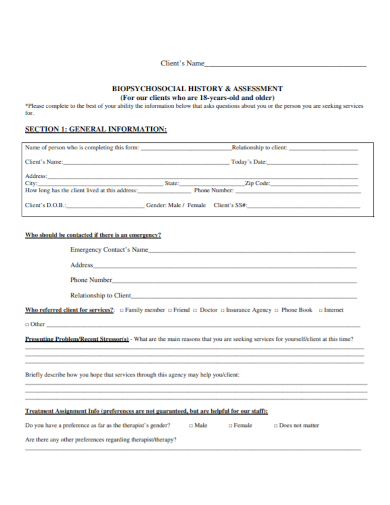A biopsychosocial assessment helps physicians, counselors, social workers, and therapists to know their clients deeper and better understand their subjective viewpoints. Biopsychosocial assessments can help physicians to diagnose and efficiently treat their clients. If you are studying how to conduct a biopsychosocial assessment properly, this article can give you some basic guidelines about the assessment. Read the article to find out how to do a client biopsychosocial assessment.
3+ Client Biopsychosocial Assessment Samples
1. Client Biopsychosocial Assessment Form
2. Client Adolescent Biopsychosocial Assessment
3. Client Biopsychosocial History Assessment
4. Client Biopsychosocial Assessment Self Report
What is a Biopsychosocial Assessment?
A biopsychosocial assessment is based on the biopsychosocial model by Dr. George Engel that explains that an individual’s biological, social and psychological factors are all entwined with each other and how these factors can affect the individual’s well-being. For example, if a person experiences a physical illness with lacking support from friends or family, the person is more likely to become depressed and anxious.
Elements of a Biopsychosocial Assessment
The biopsychosocial model has three main components. These are psychological factors, biological factors, and social factors. Below is a guide on how to conduct an assessment of a client based on these components.
1. Biological Factors
Biological factors are defined by the American Psychological Association (APA) as physical, neurological, or genetic factors associated with psychological disturbances. According to the National Institute of Mental Health, mental disorders are caused by various combinations of psychological, genetic, biological, and environmental factors. Questioning the client in regards to their biological factors helps physicians understand their medical issues and history and how these impact other areas of their life. Below is the following information a physician may ask the client to provide:
- Age
- Personal medical and mental health history
- Family’s medical and mental health history
- Diet and appetite
- Sleep and exercise habits
- Substance abuse history
2. Psychological Factors
Psychological factors explain how a person’s thought process can influence their mental state, behavior, and how it impacts their well-being. To identify psychological factors that may be influencing the client, the following information below must be obtained by the physician:
- Personality
- Psychological traumas
- Stress and coping skills
- Reaction to illness
3. Social Factors
The APA refers to social factors as aspects that affect the thought or behavior of an individual in social contexts. According to a review published in Current Psychiatry Reports, social factors, such as income level and familial relationships, can give a great impact on an individual’s mental health. For a physician to learn about a client’s social condition and how this affects their mental and physical health, the following information must be obtained
- Family relationships
- Social support
- Marital status
- Cultural influences
- Spiritual or religious background
- Hobbies
- Employment history and educational background
- Living situation
- Financial status
4. Assessment and Recommendations
After the physician has gathered the data mentioned above from the client, it’s time to write a biopsychosocial assessment report. The report must have the following details:
- The main problem of the client has and its contributing factors.
- The physician’s impression of the client, their current state, and the way they’re handling the problem.
- The physician’s assessment of the client’s motivation and urgency to change their behaviors with the help of the physician’s services.
- The physician’s diagnosis of the client.
- The long-term and short-term goals for the client to accomplish to resolve their problem.
- The treatment that the physician recommends for the client.
FAQs
How long does a biopsychosocial assessment take?
A biopsychosocial assessment can take 45 minutes to an hour.
What is a spiritual assessment?
The spiritual assessment is an assessment that physicians do to support patients through stressing empathetic listening, documenting spiritual preferences, and incorporating the patients’ faith traditions into the treatment plans. One of the great benefits of conducting a spiritual assessment is that it can help strengthen the physician-patient relationship and help the patient to be more resilient.
Keep in mind that when you’re conducting the assessment, make sure to present the information based on priority such as the primary problem and main issues that the client is having since this is usually the most important and needs urgent attention. You have to spend more time focusing on these issues in your report. And finally, your assessment report must be accurate. Make sure your information will not mislead your readers. Revise any errors. Keep in mind that other physicians will read your report. To help you get started on making a biopsychosocial assessment report, download our free sample templates provided above!
Related Posts
FREE 9+ Sample Needs Assessment Survey
FREE 9+ Software Evaluation Samples
FREE 8+ Sample Behavior Management Plan
FREE 8+ Nursing Assessment Samples
FREE 7+ Sample Health Assessment
FREE 7+ Sample Progress Notes for Social Workers
FREE 6+ Sample Nursing Assessments
FREE 13+ Tutor Evaluation Form Samples
FREE 12+ Sample Care Plan
FREE 10+ Bankruptcy Intake Form Samples
FREE 10+ Charity Questionnaire Samples
FREE 9+ Legal Client Intake Form Samples
FREE 9+ Sample Video Consent Forms
FREE 8+ Sample Psychosocial Assessment
FREE 8+ Sample Product Evaluations




